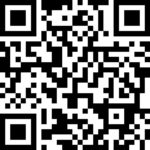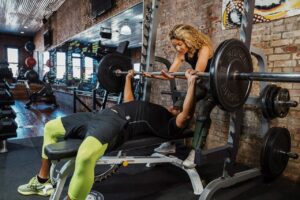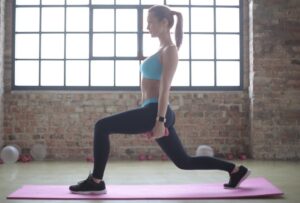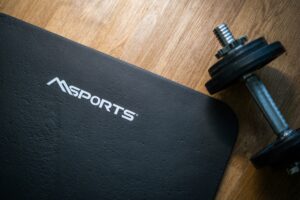Training the biceps is straightforward enough. Do a couple of curl variations one to three times per week, and watch as your arms grow.
While that is certainly one way to go about it, optimal bicep development takes a bit more attention to detail.
Read on to learn about the bicep anatomy, how to train it for optimal growth, and what short head bicep exercises you can add to your training.
Bicep Anatomy and Function
The bicep is a relatively small muscle that makes up the front of the upper arms. Its primary functions are elbow flexion (bending of the arm) and wrist supination (rotating your wrist from a neutral to a forward-facing position) (1).
As its name suggests, the bicep has two heads: a short inner and a long outer head (1). Both heads have similar origins and insertion points, which means the two run parallel to one another and work together to produce elbow flexion and wrist supination.
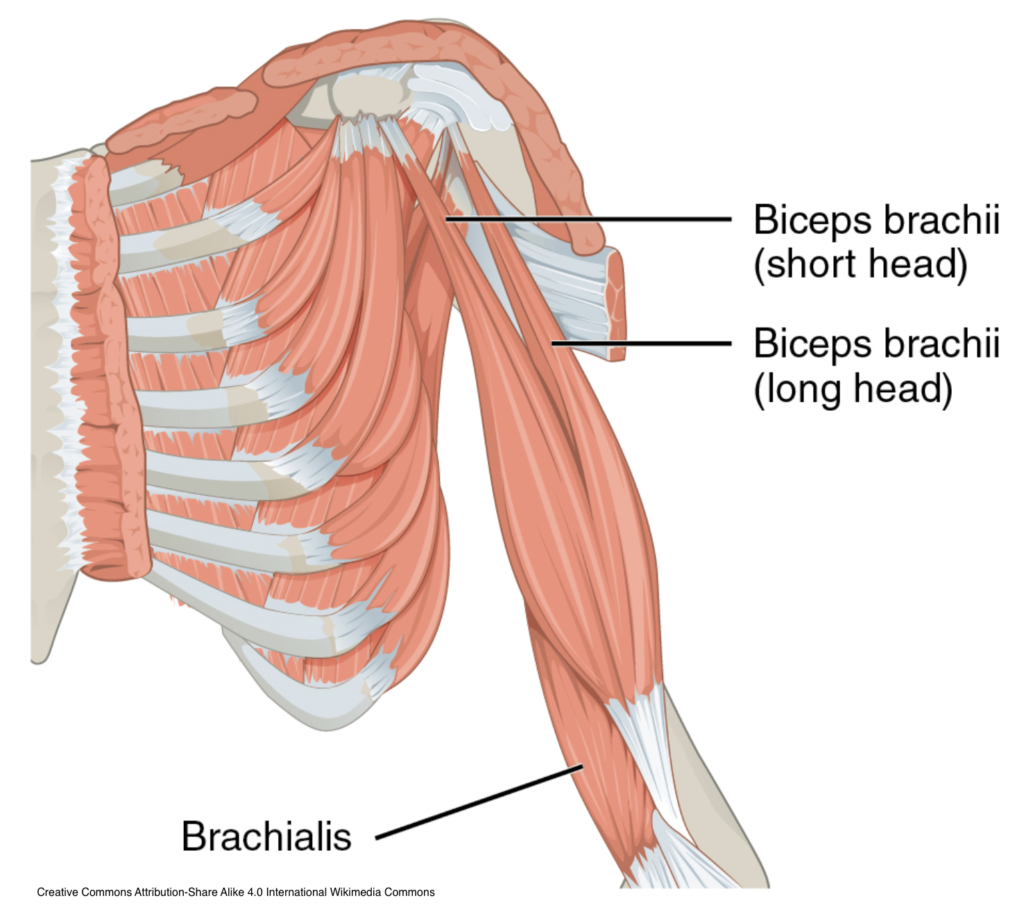
Since the biceps originate from the scapula and cross the shoulder joint, arm position relative to your torso can influence muscle activation (1). For instance, bringing your arms behind your body as you would during an incline dumbbell curl would stretch both heads of the bicep at the bottom.
Developing both portions of the muscle makes it appear taller and wider. The long head is crucial for the bicep peak, whereas a developed short head adds thickness and width to the muscle.
The good news is that you don’t necessarily need to do entire short head workouts to develop your biceps well. Instead, pick your movements wisely and ensure a healthy balance of long and short head bicep exercises.
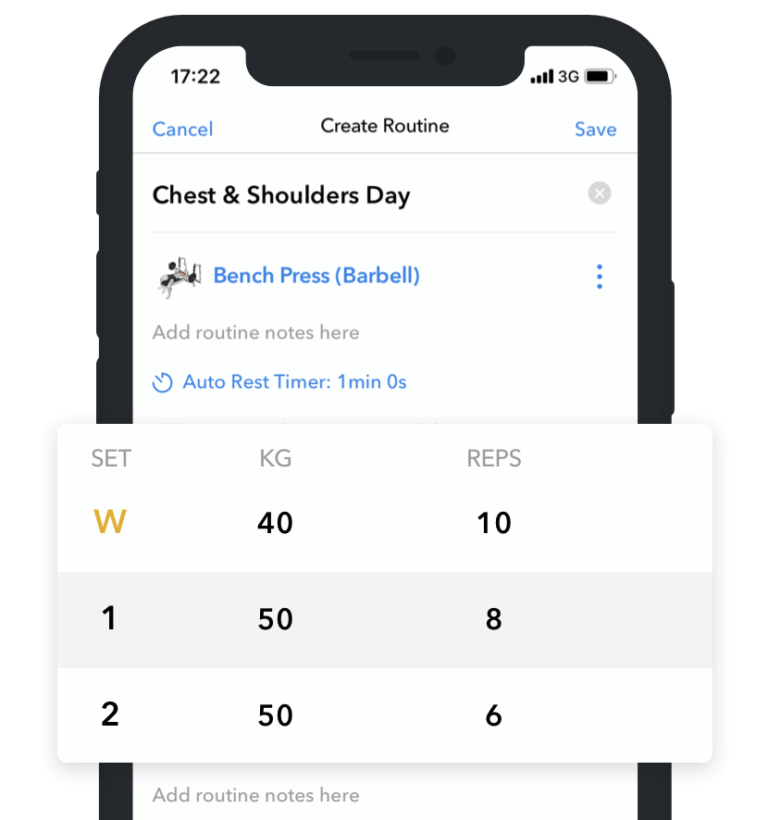






Hevy – Workout Tracker
Create and log your short head bicep exercises with Hevy, and track your progress
10 Effective Short Head Bicep Exercises for Width and Thickness
1. Wide-Grip Bicep Curl (Barbell)
Wide-grip barbell curls are one of the most straightforward exercises to emphasize the bicep’s inner portion.
Positioning your arms to your sides while doing curls reduces the involvement of the long bicep head, allowing the short one to do more work and develop.
A notable benefit of bicep curls is that you can overload the muscle with more weight and create mechanical tension, which is necessary for growth (2, 3).
How to:
- Grab a barbell with an underhand grip (palms facing forward). Your hands should be more than shoulder-width apart but not to the point where you experience joint discomfort.
- Stand tall, retract your shoulder blades, squeeze your buttocks, take a deep breath, and tense your abs.
- Curl the bar in one fluid motion, bending your arms until your wrists are slightly higher than your elbows.
- Pause at the top and slowly extend your arms, exhaling near the bottom.
Pro tip:
Start with a lighter load that allows you to do at least 12 reps to practice proper form with the exercise.
Too many trainees make the mistake of adding too much weight to the bar, which forces them to use momentum and shorten the range of motion.
2. EZ Bar Biceps Curl
EZ bar curls are identical to straight-bar curls, apart from one significant difference:
An EZ bar has a subtle ‘W’ shape that allows for a slightly more comfortable grip. Using a curved bar puts your wrists in a better position, and you’re less likely to experience joint aches. You can use a barbell if that’s all you have and if it doesn’t cause wrist pain.
Similar to a barbell curl, a wider grip will emphasize the short bicep head. One potential drawback is that an EZ bar puts your wrists in a slightly more neutral position, which can place more tension on the long bicep head.
How to:
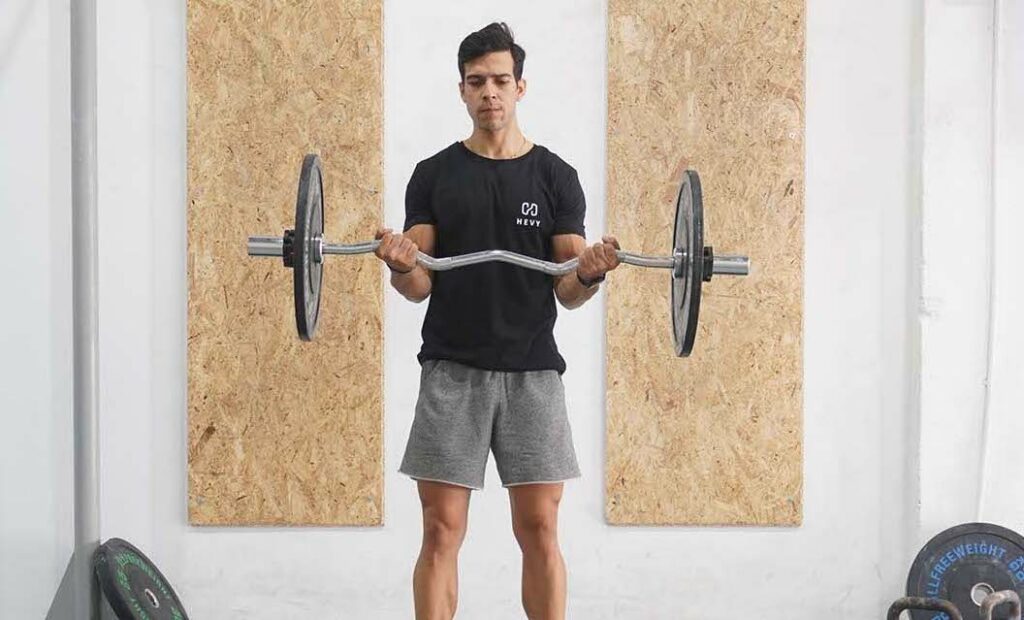

- Grab an EZ bar with a wide, underhand grip (palms facing forward).
- Stand tall, retract your shoulder blades, squeeze your buttocks, and engage your abs.
- Inhale and slowly curl the bar up until your wrists are slightly higher than your elbows. Keep your elbows to your sides as you lift the weight.
- Pause at the top and slowly extend your arms, exhaling near the bottom.
- Take another breath and repeat.
Pro tip:
Keep your elbows glued to your sides to maintain tension on your biceps. As the weight gets heavy, some trainees allow their elbows to travel back and forth during each repetition, shifting the focus to the shoulders.
Allowing the elbows to travel back and forth also shortens the bicep range of motion. Instead of fully flexing and extending your elbows, your arms move back and forth, creating the illusion of a full range of motion.
3. Wide-Grip Bicep Curl (Cable)
Wide-grip cable curls are another effective exercise for the short head of the biceps.
A notable benefit of the activity is that cables provide constant tension, which leads to better muscle activation.
Use an EZ curl attachment if your gym has one, or get a long bar that allows for a wide enough grip.
How to:
- Select the appropriate load, set the pulley to the lowest position, and attach the EZ curl bar.
- Bend forward and grab the bar attachment with an underhand grip (palms facing forward).
- Stand tall, step back, and stagger your stance for balance.
- Retract your shoulder blades, straighten your arms, position your elbows to your sides, and engage your abs.
- Inhale and curl the bar in one fluid motion, bending your arms until your wrists are slightly higher than your elbows.
- Pause at the top and slowly extend your arms, exhaling near the bottom.
- Inhale again and repeat.
Pro tip:
In addition to using a bar attachment, you can experiment with a rope or handle. When using a rope, keep your hands apart, with your forearms angled slightly to your sides. Doing so will keep the emphasis on the short bicep head.
A handle attachment is useful if you want to train one bicep at a time and fix any muscle imbalances that might have developed over time.
Related article: Back and Bicep Workouts for Building Strength
4. Seated Incline Curl (Dumbbell)
Seated incline dumbbell curls are an overlooked exercise that develops both heads of the biceps (4).
Lying back on an incline bench for curls leads to a better bicep stretch, which can contribute to remarkable growth in the long run. In addition, doing curls from such a position limits body movement and reduces the risk of momentum.
How to:
- Set the incline of a gym bench at 60 to 70 degrees, which is nearly upright.
- Grab a pair of dumbbells, sit down, and lean your back against the bench.
- Position your arms to your sides, retract your shoulder blades, and engage your abs.
- Inhale and curl both dumbbells until your wrists are slightly higher than your elbows. Keep your elbows in the same position relative to your torso from start to finish.
- Pause at the top position for a moment and slowly extend your arms as you exhale.
- Inhale again and repeat.
Pro tip:
Having your arms in such a position relative to your torso stretches the long bicep head. You can shift the emphasis to the short head by rotating your arms slightly to your sides, which would put the inner portion of the bicep at a mechanical advantage.







Hevy – Workout Tracker
Create and log your short head bicep exercises with Hevy, and track your progress
5. Overhead (Crucifix) Cable Curl
The overhead cable curl, also known as crucifix curl, is a slightly unorthodox bicep exercise that doesn’t get as much attention as it should.
To perform the movement, your arms must be pointed to your sides, which puts the short head of the bicep in a more advantageous position for elbow flexion. Plus, cables provide constant tension, leading to a stronger mind-muscle connection and better bicep activation.
You will need a wide enough cable crossover machine to train both sides of your body simultaneously.
How to:


- Set both cable pulleys in the highest position and attach handles.
- Select the appropriate load on both weight stacks.
- Grab the two handles and stand in the middle of the cable machine with your arms extended and raised to your sides.
- Retract your shoulder blades, engage your abs, and inhale.
- Simultaneously bend both arms, bringing the handles to the sides of your head.
- Squeeze your biceps and slowly extend your arms as you exhale.
- Inhale again and repeat.
Pro tip:
If you don’t have access to a wide double cable machine, you can train one arm at a time. First, set up the machine, grab the handle, stand sideways, and train one bicep. Once finished, grab the handle with your other hand, turn 180 degrees, and do the same number of reps.
6. Wide-Grip Preacher Curl (EZ Bar)
Preacher curls are another excellent bicep exercise that improves muscle activation and reduces the risk of using momentum.
Plus, having the back of your upper arms against the pad of a preacher bench prevents other muscles from contributing and making the biceps’ job easier.
Grab an EZ bar and use a wider grip to make the exercise more beneficial for the short head. Like the standing curl variations, a wider grip would allow the inner bicep to contribute more.
How to:
- Adjust the seat height so you can comfortably put the back of your upper arms against the pad of the preacher bench.
- Add the appropriate load to the EZ bar.
- Lean forward, grab the bar with an underhand grip (palms facing forward), bend your arms, and sit down. Use a wide grip as you would during a standing EZ or barbell curl.
- Position your arms on the padded platform, retract your shoulder blades, and engage your abs.
- Inhale and slowly extend your arms until they are almost straight.
- Curl the bar, squeezing your biceps at the top, and exhale.
- Inhale again and extend your arms again.
Pro tip:
You can perform preacher curls in several ways, even if you don’t have a preacher bench. One option is to set a gym bench at an incline and use it as your base. The platform will be narrower, preventing you from using an EZ bar, but you can still train with a dumbbell.
7. Spider Curl (Barbell)
The barbell spider curl is one of the best short head bicep exercises because it limits momentum, offers an excellent range of motion, and provides the necessary overload for growth.
Like preacher curls, your arms are positioned in front of your body. The difference is that your elbows are free.
A notable benefit of the exercise is that it stretches the biceps well at the bottom position, which is necessary for hypertrophy.
How to:
- Adjust the incline of a gym bench to 45 or 60 degrees.
- Set yourself up on the bench with your stomach resting against the back support.
- Reach down, grab the bar, or have a friend hand it to you.
- With your arms hanging straight down, retract your shoulder blades, squeeze your glutes, and inhale.
- Curl the bar in one fluid motion, bending your arms until your wrists are slightly higher than your elbows.
- Pause at the top for a moment and slowly extend your arms as you exhale. Keep your elbows in the same position as you curl the weight and extend your arms.
- Inhale again and repeat.
Pro tip:
Like regular curls, a wider grip will emphasize the inner portion of your biceps. Start with your hands slightly more than shoulder-width apart and experiment to find your ideal grip.
Also, consider using an EZ bar instead of a straight one to keep your wrists in a more comfortable position and prevent aches.
8. Chin Up
Chin-ups are one of the best bodyweight exercises for upper body mass and strength. The exercise primarily trains the back but also develops the biceps because of their role in elbow flexion.
An underhand grip (palms facing back) allows for a slightly longer range of motion at the elbows, resembling a regular curl. But instead of lifting a barbell or dumbbells, your body provides resistance.
A notable benefit of chin-ups is that you overload your biceps with more weight and produce greater mechanical tension, which is necessary for optimal growth (2, 3). Doing so is also beneficial for building bicep strength, allowing you to do curls and back rows with more weight.
How to:
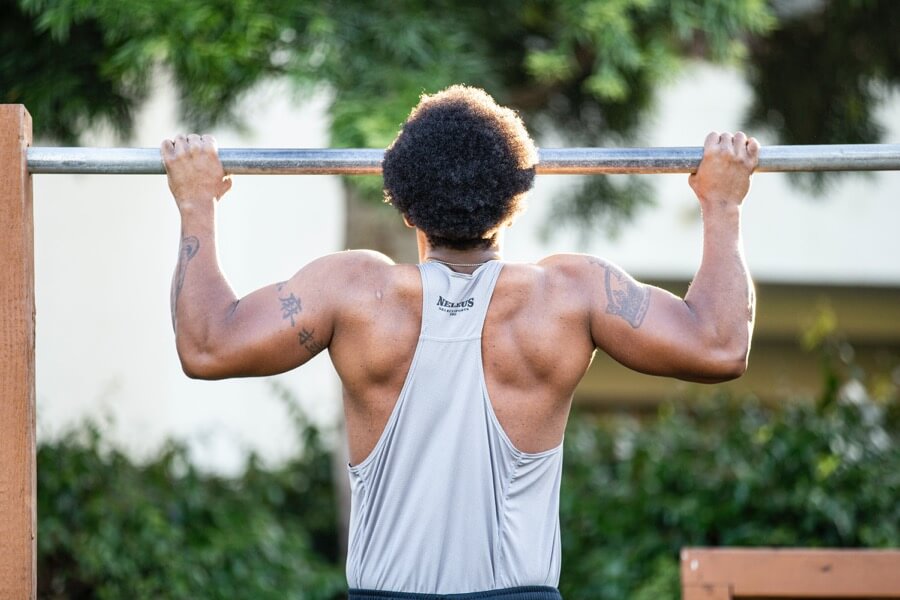

- Reach up and grab the pull-up bar with an underhand grip (palms facing back). Your hands should be roughly shoulder-width apart.
- Retract your shoulder blades, squeeze your buttocks, and tense your midsection.
- Bend your knees slightly to lift your feet off the floor, suspending yourself in the air.
- Inhale and pull yourself up until your chin is over the bar.
- Pause at the top for a moment and slowly lower yourself, keeping your core engaged to prevent swinging.
- Move down until your arms are almost straight, and exhale near the bottom.
- Inhale again and repeat.
Pro tip:
Train with a full range of motion to train your back and biceps more effectively. Lower yourself until your arms are almost entirely straight, and pull until your chin is over the bar.
You will experience a good bicep contraction at the top and a stretch at the bottom, both of which are necessary for optimal growth.
Related article: 8 Isolation and 7 Compound Bicep Exercises For Big Arms
9. Concentration Curl
Concentration curls are a practical and beginner-friendly exercise that targets the short head of the biceps.
Like preacher curls, you anchor your elbows, stopping you from using momentum and preventing your shoulders from taking over. But instead of using a preacher bench, you position the back of your upper arm against your inner thigh.
A notable benefit of concentration curls is that you can take full advantage of the movement with nothing but a dumbbell. You can sit on a flat gym bench, plyo box, or chair.
How to:
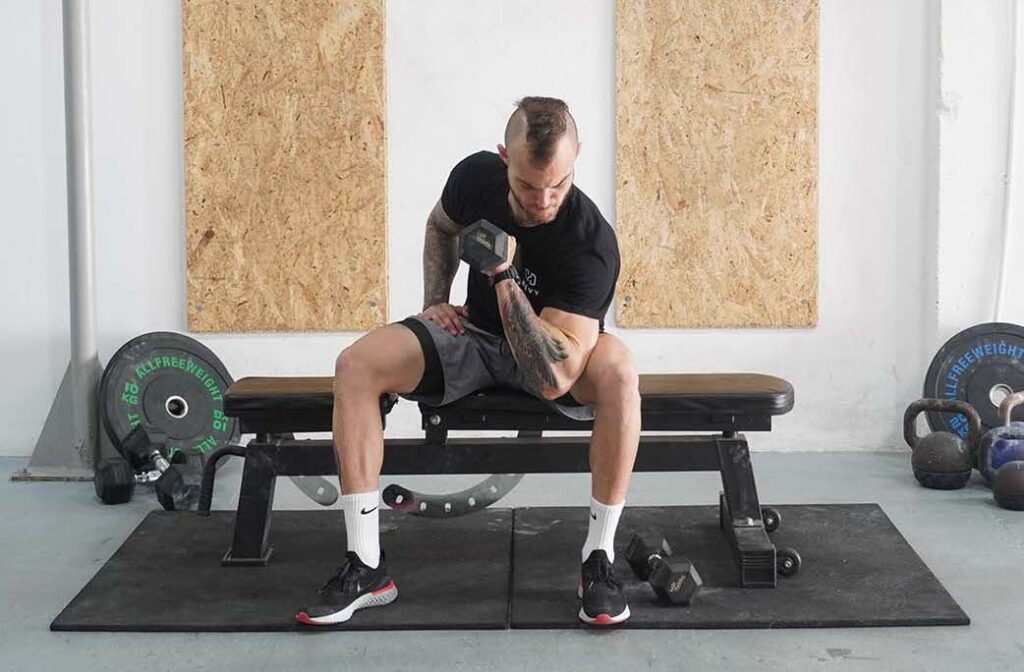

- Grab a dumbbell and sit near the edge of a flat gym bench, plyo box, or chair.
- Spread your legs wide and grab the weight with your right hand.
- Position the back of your upper arm against the inner portion of your right thigh. Your arm should be hanging straight down.
- Engage your abs, inhale, and curl the dumbbell until your wrist is slightly higher than your elbow.
- Squeeze your bicep at the top and slowly extend your arm as you exhale.
- Inhale again and repeat.
- Once finished, grab the weight with your left hand, position the back of the arm against the inner portion of your left thigh, and do the same number of reps.
Pro tip:
Keep your working arm vertical to maintain tension on your biceps. A notable mistake trainees make is to angle their supporting thigh out and lean the arm on top, which makes the exercise easier.
10. Bodyweight Curl
Bodyweight curls are an overlooked but effective exercise for training your biceps, even if you’re stuck at home with no equipment.
One way to perform the exercise at home is to take an old sheet, make a knot, place it on top of a door, and close it shut. Once the sheet is secure, grab both ends, lean your body back, and perform curls.
Alternatively, you can do the exercise by securing a barbell on a squat rack or holding onto a Smith machine bar.
How to:
- Secure a barbell or the bar of a Smith machine at chest height. You can also use a suspension kit or secure an old sheet on a door frame to perform bodyweight curls.
- Grab the bar with an underhand grip (palms facing back). Your hands should be shoulder-width apart or slightly wider.
- Straighten your body and walk your feet forward to angle your body back.
- Engage your abs, squeeze your glutes, and inhale.
- Bend your elbows to get your body closer to the bar, squeezing your biceps at the top position.
- Pause for a moment and slowly extend your arms, allowing your body to return to the starting position. Exhale.
Pro tip:
Like inverted rows, a more horizontal body position makes the exercise more challenging, whereas being more upright reduces the difficulty.
Begin with a more upright position and slowly lean your body back. You should be able to do at least eight smooth and controlled reps through a full range of motion.
Related article: Best Home Workout for Men: 8 Recommendations for All Levels
Tips on Activating the Short Bicep Head
1. Use a Wider Grip
A practical way to shift the focus to the short bicep head is to use a wider grip. Doing so places the inner portion of the biceps in a strong position, allowing them to do more work.
2. Leverage Wrist Supination
A more neutral grip, such as during hammer curls, is more beneficial for developing the long head of the biceps. In contrast, adding wrist supination (rotating your wrists from a neutral to a forward-facing position) to dumbbell exercises is an excellent way to emphasize the short bicep head.
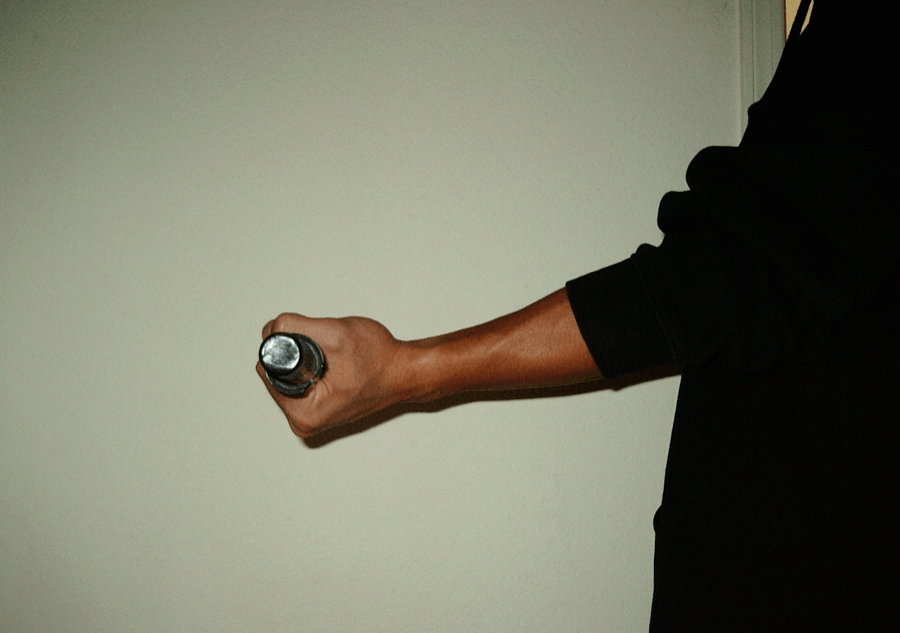

When doing dumbbell curls, start with your palms neutral and gradually rotate your hands out, squeezing your biceps at the top of each rep.
3. Tweak Your Arm Position
Keeping your arms in front of your body, such as during preacher curls, allows the short bicep head to contribute more. In contrast, extending your arms behind your body places a more significant stretch on the long bicep head.
In addition, you can angle your forearms away from your body to further target the inner bicep region. For example, angle your forearms forward and out when doing a set of dumbbell curls.
Short Head Bicep Exercises FAQs
1. How to work the short head of the bicep?
The best ways to emphasize the short bicep head are:
- Try the above exercises
- Use a wider grip
- Add wrist supination to dumbbell exercises
- Keep your arms in front of your body
- Angle your forearms slightly to the sides
2. Long head vs. short bicep head: what are the primary differences?
The long head makes up the outer portion of the biceps and is responsible for the peak. In contrast, the short head makes up the inner portion, and developing it contributes to bicep width and overall thickness.
3. Do I need short head bicep workouts for optimal development?
So long as you add some of the above exercises into your training and follow our tips on short bicep head activation, you don’t need dedicated workouts to develop the area.
4. Is the long or short head of the bicep more important?
Both heads of the bicep are essential and contribute to the muscle’s appearance and strength.
It’s best to perform short and long head exercises for optimal development.
Related article: 15 Best Long Head Bicep Exercises to Get Bigger Arms
Final Thoughts
The bicep is a relatively small muscle with straightforward functions. Still, it benefits from an intelligent and nuanced training approach.
Above are 10 of the best bicep short head exercises. Experiment with some of them; don’t be afraid to tweak your technique until you find what works best.







Hevy – Workout Tracker
Create and log your short head bicep exercises with Hevy, and track your progress
Check out the Hevy app if you want more exercise ideas or need a simple and practical way to log your workouts.

